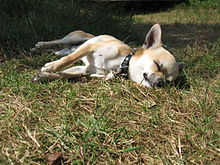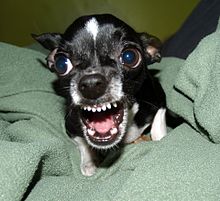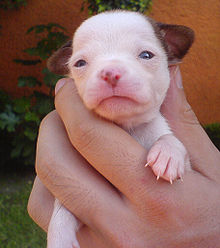- Chihuahua (dog)
-
Chihuahua 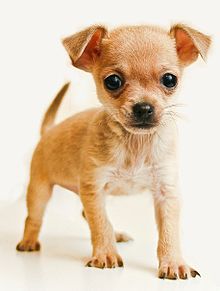
Other names Chihuahueño Nicknames "New Yorker" (Mexico only) Country of origin Mexico Traits Weight Male Under 6 pounds (Under 3 kilograms) Female Under 6 pounds (Under 3 kilograms) Height Male 6–10 inches (15–23 centimeters) Female 6–10 inches (15–23 centimeters) Coat smooth or long haired Color white, black, tan and many other colors Litter size normally 4 Life span 14–18 years Classification and standards FCI Group 9 Section 6 #218 standard AKC Toy standard ANKC Group 1 (Toys) [Smooth Stds
Long standard]CKC Group 5 - Toys standard KC (UK) Toy [Smooth Stds
Long standard]NZKC Toy [Smooth Stds
Long standard]UKC Companion Breeds standard Dog (Canis lupus familiaris) The
 Chihuahua (help·info) (Spanish: Chihuahueño) is the smallest breed of dog and is so named for the state of Chihuahua in Mexico. Chihuahuas come in a wide variety of sizes, head shapes, colors and coat lengths.
Chihuahua (help·info) (Spanish: Chihuahueño) is the smallest breed of dog and is so named for the state of Chihuahua in Mexico. Chihuahuas come in a wide variety of sizes, head shapes, colors and coat lengths.Contents
History
The Chihuahua’s history is puzzling and there are many theories surrounding the origin of the breed. Both folklore and archeological finds show that the breed originated in Mexico. The most common theory and most likely is that Chihuahuas are descended from the Techichi, a companion dog favored by the Toltec civilization in Mexico;[1] however, no records of the Techichi are available prior to the 9th century. It is probable that earlier ancestors were present prior to the Mayans as dogs approximating the Chihuahua are found in materials from the Pyramids of Cholula, predating 1530 and in the ruins of Chichen Itza on the Yucatán Peninsula.[1]
Some historians believe that the Chihuahua came from the island of Malta in the Mediterranean.[2] More evidence for this theory lies in European paintings of small dogs that resemble the Chihuahua. One of the most famous paintings is a fresco in the Sistine Chapel by Sandro Botticelli dated 1480–1482. The fresco, depicting the Trials of Moses, shows a boy holding a tiny dog with round head, large eyes, big ears, and other characteristics similar to those of the Chihuahua.[3] The painting was finished ten years before Columbus returned from the New World. It would have been impossible for Botticelli to have seen a Mexican dog, yet he depicted an animal strikingly similar to a Chihuahua.
A progenitor of the breed was reputedly found in 1850 in old ruins near Casas Grandes in the Mexican state of Chihuahua from which the breed gets its name,[4] although most artifacts relating to its existence are found around Mexico City. The state borders Texas, Arizona and New Mexico in the United States, where Chihuahuas first rose to prominence. Since that time, the Chihuahua has remained consistently popular as a breed, particularly in America when the breed was first recognized by the American Kennel Club in 1904. In terms of size, the present day Chihuahua is much smaller than its ancestors, a change thought to be due to the introduction of miniaturized Chinese dogs, such as the Chinese crested dog, into South America by the Spanish.
Description and standards
Breed standards for this dog do not generally specify a height, only a weight and a description of their overall proportions. As a result, height varies more than within many other breeds. Generally, the height ranges between six and ten inches; however, some dogs grow as tall as 12 to 15 inches (30 to 38 cm). Both British and American breed standards state that a Chihuahua must not weigh more than six pounds for conformation. However, the British standard also states that a weight of two to four pounds is preferred and that if two dogs are equally good in type, the more diminutive one is preferred. The Fédération Cynologique Internationale (FCI) standard calls for dogs ideally between 1.5 and 3.0 kg (3.3 to 6.6 lbs.), although smaller ones are acceptable in the show ring.[5] Pet-quality Chihuahuas (that is, those bred or purchased as companions rather than show dogs) often range above these weights, even above ten pounds if they have large bone structures or are allowed to become overweight. This does not mean that they are not purebred Chihuahuas; they do not meet the requirements to enter a conformation show. Oversized Chihuahuas are seen in some of the best, and worst, bloodlines. Typically the breed standard for both the long and short coat chihuahua will be identical except for the description of the coat.
Chihuahua breeders often use terms like Teacup, Pocket Size, Tiny Toy, Miniature or Standard to describe puppies. These terms are not recognized by the breed standards and are considered marketing gimmicks to inflate the value of puppies.[6] Chihuahuas are commonly referred to as either Apple heads or Deer heads,[7] the former having short noses and rounded heads similar to that of an apple; the latter having longer noses and more elongated heads.
Coat
The Kennel Club in the United Kingdom and the American Kennel Club in the United States only recognize two varieties of Chihuahua: the long-coat, and the smooth-coat, also referred to as short-haired.[8] They are genetically the same breed. The term smooth-coat does not mean that the hair is necessarily smooth, as the hair can range from having a velvet touch to a whiskery feeling. Long-haired Chihuahuas are actually smoother to the touch, having soft, fine guard hairs and a downy undercoat, which gives them their fluffy appearance. Unlike many long-haired breeds, long-haired Chihuahuas require no trimming and minimal grooming. Contrary to popular belief, the long-haired breed also typically sheds less than their short-haired counterparts. It may take up to two or more years before a full long-haired coat develops.
Colors
Chihuahuas come in virtually any color combination, from solid to marked or splashed,[8] allowing for colors from solid black to solid white, spotted, sabled, or a variety of other colors and patterns. Colors and patterns can combine and affect each other, resulting in a very high degree of variation. Common colors are fawn, red, cream, chocolate, blue, and black. No color or pattern is considered more valuable than another.
The merle coat pattern, which appears mottled, is not traditionally considered part of the breed standard. In May 2007, The Kennel Club decided not to register puppies with this coloration due to the health risks associated with the responsible gene, and in December of that year formally amended the Breed Standard to disqualify merle dogs.[9] The Fédération Cynologique Internationale, which represents the major kennel club of 84 countries, also disqualified merle.[10] Other countries' kennel clubs, including Canada, Australia, New Zealand, and Germany, have also disqualified merle. However, in May 2008, the Chihuahua Club of America voted that merles would not be disqualified in the United States, and would be fully registrable and able to compete in American Kennel Club (AKC) events. Opponents of merle recognition suspect the coloration came about by modern cross-breeding with other dogs, and not via natural genetic drift.[citation needed]
Temperament
A Chihuahua must be chosen with care, as the temperament of its owner can make a difference in the temperament of the pup. Ill tempered Chihuahuas can be easily provoked to attack, and are therefore generally unsuitable for homes with small children.[11] The breed tends to be fiercely loyal to one particular owner and in some cases may become over protective of the person, especially around other people or animals.If properly managed by older children, 13 and up, they can adapt to this kind of living with a dedicated owner.[12] They do not always get along with other breeds,[11] and tend to have a "clannish" nature, often preferring the companionship of other Chihuahuas over other dogs.[13] These traits generally make them unsuitable for households with children that are not patient and calm.[8] Chihuahuas love their dens and will often burrow themselves in pillows, clothes hampers, and blankets. They are often found under the covers or at the bottom of the bed, deep in the dark and safety of what they believe is their den.
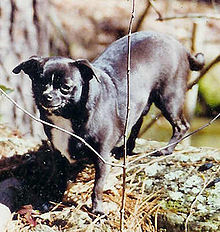 Overfeeding a Chihuahua can be a great danger to the dog's health, shortening its life and leading to diabetes.[14]
Overfeeding a Chihuahua can be a great danger to the dog's health, shortening its life and leading to diabetes.[14]
Health disorders
This breed requires expert veterinary attention in areas such as birthing and dental care. Chihuahuas are also prone to some genetic anomalies, often neurological ones, such as epilepsy and seizure disorders.
Chihuahuas, and other toy breeds, are prone to the sometimes painful disease hydrocephalus. It is often diagnosed by the puppy having an abnormally large head, or hydrocephalus, during the first several months of life, but other symptoms are more noticeable since "a large head" is such a broad description. Chihuahua puppies exhibiting hydrocephalus usually have patchy skull plates rather than a solid bone and typically are lethargic and do not grow at the same pace as their siblings. A true case of hydrocephalus can be diagnosed by a veterinarian, though the prognosis is grim.
Chihuahuas have moleras, or a soft spot in their skulls, and they are the only breed of dog to be born with an incomplete skull. The molera fills in with age, but great care needs to be taken during the first six months until the skull is fully formed. Some moleras do not close completely and will require extra care to prevent injury. Many veterinarians are not familiar with Chihuahuas as a breed and mistakenly confuse a molera with hydrocephalus.[15]
Chihuahuas can also be at risk for hypoglycemia, or low blood sugar, which is especially dangerous for puppies. Left unattended, hypoglycemia can lead to coma and death but can be avoided with frequent feedings, such as every three hours for very small or young puppies. Chihuahua owners should have a simple sugar supplement on hand to use in emergencies, such as, Nutri-Cal, Karo syrup or honey. These supplements can be rubbed on the gums and roof of the mouth to rapidly raise the blood sugar level. Signs of hypoglycemia include lethargy, sleepiness, low energy, uncoordinated walking, unfocused eyes and spasms of the neck muscles or head pulling back or to the side.
Chihuahuas are prone to eye infections or eye injury due to their large, round, protruding eyes and their relatively low ground clearance. Care should be taken to prevent visitors or children from poking the eyes. The eyes also water frequently to remove dust or allergens that may get into the eye. Daily wiping will keep the eyes clean and prevent tear staining.
Collapsed trachea (reverse sneezing) is a health concern that is characteristic of the chihuahua breed.[16]
Chihuahuas have a tendency to tremble but it is not a health issue. Instead, it occurs mainly when the dog is stressed, excited or cold. Cold can also present a problem for these small animals. They often enjoy wearing coats or sweaters when outside and enjoy digging and snuggling in blankets when sleeping.
Although figures often vary, as with any breed, the average lifespan range for a healthy Chihuahua is between 10 and 17 years.
Chihuahuas are sometimes picky eaters and care must be taken to provide them with adequate nutrition. Sometimes wet or fresh food can have the most appealing smell to these constant eaters. Chihuahuas are prone to hypoglycemia and could be at a critical state if allowed to go too long without a meal. At the same time, care must be exercised not to overfeed them.
Chihuahuas have a notorious problem with dental issues. Dental care is a must for these little creatures. Human food should be avoided. Due to their small size, even tiny high fat or sugary treats can result in an overweight Chihuahua. Overweight Chihuahuas are susceptible to having an increased rate of joint injuries, tracheal collapse, chronic bronchitis, and shortened life span.
Chihuahuas are also known for a genetic condition called 'luxating Patella,' a genetic condition that can occur in all dogs. In some dogs, the ridges forming the patellar groove are not shaped correctly and a shallow groove is created. In a dog with shallow grooves, the patella will luxate or slip out of place, sideways. It causes the leg to 'lock up' and will force the chihuahua to hold its foot off the ground. When the patella luxates from the groove of the femur, it usually cannot return to its normal position until the quadriceps muscle relaxes and increases in length, explaining why the affected dog may be forced to hold his leg up for a few minutes or so after the initial displacement. While the muscles are contracted and the patella is luxated from its correct position, the joint is held in the flexed or bent position. The knee cap sliding across the femur can cause some pain due to the bony ridges of the femur. Once out of position, the animal feels no discomfort and continues with activity.
Chihuahuas are also prone to some heart related disorders such as heart murmurs and Pulmonic Stenosis, a condition in which the blood outflow from the heart's right ventricle is obstructed at the pulmonic valve.[17]
Chihuahuas, along with other miniature dogs such as Chinese Cresteds, are prone to physical deformities, especially in old age; several chihuahuas and cross-bred chihuahua/Chinese crested mixes have rated highly in the World's Ugliest Dog Contest, including a purebred chihuahua named Princess Abby that won the 2010 contest and a crossbreed named Yoda that won the 2011 contest.
See also
References
- ^ a b "American Kennel Club - Chihuahua History". http://www.akc.org/breeds/chihuahua/history.cfm. Retrieved 2011-04-03.
- ^ "Chihuahua Dog History". http://www.chihuahua-rama.com/chihuahua-dog-history.html. Retrieved 08-07-10.
- ^ "Chihuahua in Art History". http://www.prouxchihuahuas.com/id104.html. Retrieved 03-07-11.
- ^ Chihuahuas: facts and information, Tenna Perry, Assortment.com, 2002, retrieved on July 29, 2007
- ^ "FCI-Standard N° 218 / 15.9.2010 / GB". Fédération Cynologique Internationale. 07-28-2009. http://www.fci.be/uploaded_files/218g09-en.doc. Retrieved 2011-10-25.
- ^ "CCA-Teacup Statement". Chihuahuaclubofamerica.com. 2009-05-30. http://chihuahuaclubofamerica.com/index.php?option=com_content&view=article&id=51&Itemid=60. Retrieved 2011-01-19.
- ^ "Types Of Chihuahua". Thechihuahuaguide.com. 2007. http://www.thechihuahuaguide.com/Types_of_Chihuahua/. Retrieved 2011-01-20.
- ^ a b c American Kennel Club Chihuahua page, retrieved on July 29, 2007.
- ^ "Kennel Club breed standard". Thekennelclub.org.uk. 2006-05-15. http://www.thekennelclub.org.uk/item/183. Retrieved 2009-08-14.
- ^ "FCI-Standard N° 218 / 21.10.2009 / GB". Fédération Cynologique Internationale. 07-28-2009. http://www.fci.be/uploaded_files/218GB2009.doc. Retrieved 2010-07-21.
- ^ a b The Chihuahua, Dog Owners Guide at canismajor.com.
- ^ "Chihuahua". dogbreedinfo.com. http://www.dogbreedinfo.com/chihuahua.htm. Retrieved 2011-04-03.
- ^ About Chihuahuas, British Chihuahua Club, retrieved on July 29, 2007.
- ^ Pet Health 101 - Chihuahua, retrieved on July 29, 2007
- ^ Molera Statement
- ^ tracheal collapse in chihuahuas: a chihuahua respiratory problem
- ^ Chihuahua Health, Dog-breeds.in
External links
Categories:- Toy dogs
- Companion dogs
- Dog breeds originating in Mexico
- Mexican folklore
Wikimedia Foundation. 2010.



